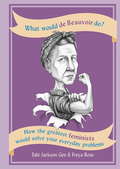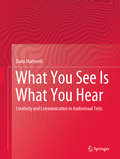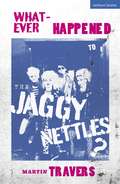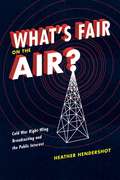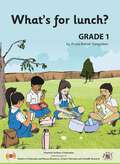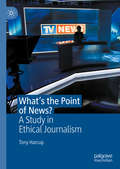- Table View
- List View
What Would de Beauvoir Do: How the greatest feminists would solve your everyday problems
by Tabi Jackson Gee Freya RoseEver thought about what Tinder advice Naomi Wolf would give you?Ever wondered what Andrea Dworkin would think about your Brazilian wax? Or what Mary Wollstonecraft would think about the 'fairy-tale' weddings you're always invited to? Using 40 everyday questions and problems as springboards for exploring the theories and concepts of the greatest feminist theorists of all time, from the pioneering writer of The Second Sex, Simone de Beauvoir to modern-day icons such as Chimamanda Ngozi Adichie What Would de Beauvoir Do? tackles all the important issues in your life through a feminist lens.From Audre Lorde to Roxane Gay, Virginia Woolf to Caitlin Moran, let the most influential feminists in history answer all your everyday questions, and in doing so shed light on even the most complex feminist theories.
What Writers Read: 35 Writers on their Favourite Book
by Pandora SykesIn this love letter to reading, curated by Pandora Sykes in aid of the National Literacy Trust, bestselling and beloved writers share their favourite books: the ones they hold most dearly, that they return to time and again and that helped make them the writers they are.WITH CONTRIBUTIONS FROM : NICK HORNBY * RUTH OZEKI * ANN PATCHETT * BENJAMIN ZEPHANIAH * MARIAN KEYES * ELIZABETH STROUT * DEBORAH LEVY * TESSA HADLEY * ELIF SHAFAK * GEORGE THE POET * LEILA SLIMANI * ALI SMITH * DEREK OWUSU * DOLLY ALDERTON * PARIS LEES * JOJO MOYES * PAUL MENDEZ * SEBASTIAN FAULKS * DIANA EVANS * MEENA KANDASAMY * LISA TADDEO * NIKESH SHUKLA * TAIYE SELASI * MONICA ALI * NINA STIBBE * CALEB AZUMAH NELSON * ELIZABETH DAY * SARA COLLINS * DAMON GALGUT * NAOISE DOLAN * WILLIAM BOYD * EMMA DABIRI * FATIMA BHUTTO * KIT DE WAAL
What Writers Read: 35 Writers on their Favourite Book
by Pandora SykesIn this love letter to reading, curated by Pandora Sykes in aid of the National Literacy Trust, bestselling and beloved writers share their favourite books: the ones they hold most dearly, that they return to time and again and that helped make them the writers they are.WITH CONTRIBUTIONS FROM : NICK HORNBY * RUTH OZEKI * ANN PATCHETT * BENJAMIN ZEPHANIAH * MARIAN KEYES * ELIZABETH STROUT * DEBORAH LEVY * TESSA HADLEY * ELIF SHAFAK * GEORGE THE POET * LEILA SLIMANI * ALI SMITH * DEREK OWUSU * DOLLY ALDERTON * PARIS LEES * JOJO MOYES * PAUL MENDEZ * SEBASTIAN FAULKS * DIANA EVANS * MEENA KANDASAMY * LISA TADDEO * NIKESH SHUKLA * TAIYE SELASI * MONICA ALI * NINA STIBBE * CALEB AZUMAH NELSON * ELIZABETH DAY * SARA COLLINS * DAMON GALGUT * NAOISE DOLAN * WILLIAM BOYD * EMMA DABIRI * FATIMA BHUTTO * KIT DE WAAL
What Writing Does and How It Does It: An Introduction to Analyzing Texts and Textual Practices
by Charles Bazerman Paul PriorIn What Writing Does and How It Does It, editors Charles Bazerman and Paul Prior offer a sophisticated introduction to methods for understanding, studying, and analyzing texts and writing practices. This volume addresses a variety of approaches to analyzing texts, and considers the processes of writing, exploring textual practices and their contexts, and examining what texts do and how texts mean rather than what they mean. Included are traditional modes of analysis (rhetorical, literary, linguistic), as well as newer modes, such as text and talk, genre and activity analysis, and intertextual analysis. The chapters have been developed to provide answers to a specified set of questions, with each one offering:*a preview of the chapter's content and purpose; *an introduction to basic concepts, referring to key theoretical and research studies in the area;*details on the types of data and questions for which the analysis is best used; *examples from a wide-ranging group of texts, including educational materials, student writing, published literature, and online and electronic media; *one or more applied analyses, with a clear statement of procedures for analysis and illustrations of a particular sample of data; and*a brief summary, suggestions for additional readings, and a set of activities. The side-by-side comparison of methods allows the reader to see the multi-dimensionality of writing, facilitating selection of the best method for a particular research question. The volume contributors are experts from linguistics, communication studies, rhetoric, literary analysis, document design, sociolinguistics, education, ethnography, and cultural psychology, and each utilizes a specific mode of text analysis. With its broad range of methodological examples, What Writing Does and How It Does It is a unique and invaluable resource for advanced undergraduate and graduate students and for researchers in education, composition, ESL and applied linguistics, communication, L1 and L2 learning, print media, and electronic media. It will also be useful in all social sciences and humanities that place importance on texts and textual practices, such as English, writing, and rhetoric.
What You See Is What You Hear: Creativity and Communication in Audiovisual Texts
by Dario MartinelliWhat You See Is What You Hear develops a unique model of analysis that helps students and advanced scholars alike to look at audiovisual texts from a fresh perspective. Adopting an engaging writing style, the author draws an accessible picture of the field, offering several analytical tools, historical background, and numerous case studies. Divided into five main sections, the monograph covers problems of definitions, history, and most of all analysis. The first part raises the main problems related to audiovisuality, including taxonomical and historical questions. The second part provides the bases for the understanding of audiovisual creative communication as a whole, introducing a novel theoretical model for its analysis. The next three part focus elaborate on the model in all its constituents and with plenty of case studies taken from the field of cinema, TV, music videos, advertising and other forms of audiovisuality. Methodologically, the book is informed by different paradigms of film and media studies, multimodality studies, structuralism, narratology, “auteur theory” in the broad sense, communication studies, semiotics, and the so-called “Numanities.” What You See Is What You Hear enables readers to better understand how to analyze the structure and content of diverse audiovisual texts, to discuss their different idioms, and to approach them with curiosity and critical spirit.
WhatAMelon: Comforting pick-you-ups for epic fails
by WhatAMelonIf you know a pearfect numpty who needs a bit of sage advice, chia them up with this little book of upbeat and adorkable fruit puns.#youokalehun?About the seriesThis cute and colourful series of fruit-pun-filled gift books are the perfect pick-me-ups for you, your friend or your partner in crime. Do you need to avocuddle, or are you grapeful for someone who's a bit of a melon? Then share the clove with these little books: AvoCuddle, WhataMelon, You are my Raisin for Living, Don't Give a Fig, I am Grapeful, You are 24 Carrot Gold.*veg, nuts and seeds are fair game
Whatcha Mean, What's a Zine?: The Art of Making Zines and Mini-Comics (PDF)
by Esther Watson Mark ToddA complete how-to guide for teens on personal writing and self-publishing in the form of zines, this resource includes tips and tricks from creators at the forefront of the zine revolution, including John Porcellino, Dave Kiersh, and Allison Cole. Illustrations.
Whatever Happened to the Jaggy Nettles? (Modern Plays)
by Martin TraversWe're a punk band. A politically motivated Marxist punk band thit waants tae bring doun the rich by any means necessary!It's 1978. Unemployment and violence darken every Glasgow close; Scotland have been knocked out of the World Cup; Grease is at the top of the charts and seminal Scottish punk band The Jaggy Nettles are imploding.The Jaggy Nettles will be reuniting on stage to perform brand new punk-inspired songs, keeping the spirit of '78 alive.Whatever Happened to the Jaggy Nettles? redefines young punks of the 1970s as naive, asexual, idealistic, poetic, wonderful and doomed. It is a play about empowerment and feeling the future is there to be changed; a story as relevant today as ever.This edition was published to coincide with the February 2020 run at Scottish Youth Theatre.
Whatever Happened to the Jaggy Nettles? (Modern Plays)
by Martin TraversWe're a punk band. A politically motivated Marxist punk band thit waants tae bring doun the rich by any means necessary!It's 1978. Unemployment and violence darken every Glasgow close; Scotland have been knocked out of the World Cup; Grease is at the top of the charts and seminal Scottish punk band The Jaggy Nettles are imploding.The Jaggy Nettles will be reuniting on stage to perform brand new punk-inspired songs, keeping the spirit of '78 alive.Whatever Happened to the Jaggy Nettles? redefines young punks of the 1970s as naive, asexual, idealistic, poetic, wonderful and doomed. It is a play about empowerment and feeling the future is there to be changed; a story as relevant today as ever.This edition was published to coincide with the February 2020 run at Scottish Youth Theatre.
What's Fair on the Air?: Cold War Right-Wing Broadcasting and the Public Interest
by Heather HendershotThe rise of right-wing broadcasting during the Cold War has been mostly forgotten today. But in the 1950s and ’60s you could turn on your radio any time of the day and listen to diatribes against communism, civil rights, the United Nations, fluoridation, federal income tax, Social Security, or JFK, as well as hosannas praising Barry Goldwater and Jesus Christ. Half a century before the rise of Rush Limbaugh and Glenn Beck, these broadcasters bucked the FCC’s public interest mandate and created an alternate universe of right-wing political coverage, anticommunist sermons, and pro-business bluster. A lively look back at this formative era, What’s Fair on the Air? charts the rise and fall of four of the most prominent right-wing broadcasters: H. L. Hunt, Dan Smoot, Carl McIntire, and Billy James Hargis. By the 1970s, all four had been hamstrung by the Internal Revenue Service, the FCC’s Fairness Doctrine, and the rise of a more effective conservative movement. But before losing their battle for the airwaves, Heather Hendershot reveals, they purveyed ideological notions that would eventually triumph, creating a potent brew of religion, politics, and dedication to free-market economics that paved the way for the rise of Ronald Reagan, the Moral Majority, Fox News, and the Tea Party.
What's Fair on the Air?: Cold War Right-Wing Broadcasting and the Public Interest
by Heather HendershotThe rise of right-wing broadcasting during the Cold War has been mostly forgotten today. But in the 1950s and ’60s you could turn on your radio any time of the day and listen to diatribes against communism, civil rights, the United Nations, fluoridation, federal income tax, Social Security, or JFK, as well as hosannas praising Barry Goldwater and Jesus Christ. Half a century before the rise of Rush Limbaugh and Glenn Beck, these broadcasters bucked the FCC’s public interest mandate and created an alternate universe of right-wing political coverage, anticommunist sermons, and pro-business bluster. A lively look back at this formative era, What’s Fair on the Air? charts the rise and fall of four of the most prominent right-wing broadcasters: H. L. Hunt, Dan Smoot, Carl McIntire, and Billy James Hargis. By the 1970s, all four had been hamstrung by the Internal Revenue Service, the FCC’s Fairness Doctrine, and the rise of a more effective conservative movement. But before losing their battle for the airwaves, Heather Hendershot reveals, they purveyed ideological notions that would eventually triumph, creating a potent brew of religion, politics, and dedication to free-market economics that paved the way for the rise of Ronald Reagan, the Moral Majority, Fox News, and the Tea Party.
What's Fair on the Air?: Cold War Right-Wing Broadcasting and the Public Interest
by Heather HendershotThe rise of right-wing broadcasting during the Cold War has been mostly forgotten today. But in the 1950s and ’60s you could turn on your radio any time of the day and listen to diatribes against communism, civil rights, the United Nations, fluoridation, federal income tax, Social Security, or JFK, as well as hosannas praising Barry Goldwater and Jesus Christ. Half a century before the rise of Rush Limbaugh and Glenn Beck, these broadcasters bucked the FCC’s public interest mandate and created an alternate universe of right-wing political coverage, anticommunist sermons, and pro-business bluster. A lively look back at this formative era, What’s Fair on the Air? charts the rise and fall of four of the most prominent right-wing broadcasters: H. L. Hunt, Dan Smoot, Carl McIntire, and Billy James Hargis. By the 1970s, all four had been hamstrung by the Internal Revenue Service, the FCC’s Fairness Doctrine, and the rise of a more effective conservative movement. But before losing their battle for the airwaves, Heather Hendershot reveals, they purveyed ideological notions that would eventually triumph, creating a potent brew of religion, politics, and dedication to free-market economics that paved the way for the rise of Ronald Reagan, the Moral Majority, Fox News, and the Tea Party.
What's Fair on the Air?: Cold War Right-Wing Broadcasting and the Public Interest
by Heather HendershotThe rise of right-wing broadcasting during the Cold War has been mostly forgotten today. But in the 1950s and ’60s you could turn on your radio any time of the day and listen to diatribes against communism, civil rights, the United Nations, fluoridation, federal income tax, Social Security, or JFK, as well as hosannas praising Barry Goldwater and Jesus Christ. Half a century before the rise of Rush Limbaugh and Glenn Beck, these broadcasters bucked the FCC’s public interest mandate and created an alternate universe of right-wing political coverage, anticommunist sermons, and pro-business bluster. A lively look back at this formative era, What’s Fair on the Air? charts the rise and fall of four of the most prominent right-wing broadcasters: H. L. Hunt, Dan Smoot, Carl McIntire, and Billy James Hargis. By the 1970s, all four had been hamstrung by the Internal Revenue Service, the FCC’s Fairness Doctrine, and the rise of a more effective conservative movement. But before losing their battle for the airwaves, Heather Hendershot reveals, they purveyed ideological notions that would eventually triumph, creating a potent brew of religion, politics, and dedication to free-market economics that paved the way for the rise of Ronald Reagan, the Moral Majority, Fox News, and the Tea Party.
What's Fair on the Air?: Cold War Right-Wing Broadcasting and the Public Interest
by Heather HendershotThe rise of right-wing broadcasting during the Cold War has been mostly forgotten today. But in the 1950s and ’60s you could turn on your radio any time of the day and listen to diatribes against communism, civil rights, the United Nations, fluoridation, federal income tax, Social Security, or JFK, as well as hosannas praising Barry Goldwater and Jesus Christ. Half a century before the rise of Rush Limbaugh and Glenn Beck, these broadcasters bucked the FCC’s public interest mandate and created an alternate universe of right-wing political coverage, anticommunist sermons, and pro-business bluster. A lively look back at this formative era, What’s Fair on the Air? charts the rise and fall of four of the most prominent right-wing broadcasters: H. L. Hunt, Dan Smoot, Carl McIntire, and Billy James Hargis. By the 1970s, all four had been hamstrung by the Internal Revenue Service, the FCC’s Fairness Doctrine, and the rise of a more effective conservative movement. But before losing their battle for the airwaves, Heather Hendershot reveals, they purveyed ideological notions that would eventually triumph, creating a potent brew of religion, politics, and dedication to free-market economics that paved the way for the rise of Ronald Reagan, the Moral Majority, Fox News, and the Tea Party.
What's Fair on the Air?: Cold War Right-Wing Broadcasting and the Public Interest
by Heather HendershotThe rise of right-wing broadcasting during the Cold War has been mostly forgotten today. But in the 1950s and ’60s you could turn on your radio any time of the day and listen to diatribes against communism, civil rights, the United Nations, fluoridation, federal income tax, Social Security, or JFK, as well as hosannas praising Barry Goldwater and Jesus Christ. Half a century before the rise of Rush Limbaugh and Glenn Beck, these broadcasters bucked the FCC’s public interest mandate and created an alternate universe of right-wing political coverage, anticommunist sermons, and pro-business bluster. A lively look back at this formative era, What’s Fair on the Air? charts the rise and fall of four of the most prominent right-wing broadcasters: H. L. Hunt, Dan Smoot, Carl McIntire, and Billy James Hargis. By the 1970s, all four had been hamstrung by the Internal Revenue Service, the FCC’s Fairness Doctrine, and the rise of a more effective conservative movement. But before losing their battle for the airwaves, Heather Hendershot reveals, they purveyed ideological notions that would eventually triumph, creating a potent brew of religion, politics, and dedication to free-market economics that paved the way for the rise of Ronald Reagan, the Moral Majority, Fox News, and the Tea Party.
What’s for lunch? class 1 - MIE
by Aruna Ankiah Gangadeen"What's for Lunch?" invites Grade 1 readers into a delightful lunchtime scene with Ben and his friends. As the bell rings, signaling lunch, the children eagerly gather under a tree, unpacking their lunch bags filled with delectable treats. Excitement fills the air as they share their delicious meals – from Ben's favorite sausage and lettuce sandwich to Sara's crispy chips with ketchup, Rishi's flavorful fried rice with vegetables and chicken, and Anna's tempting chocolate cake, generously offered to her friends. Through engaging illustrations and simple language, the book captures the joy of mealtime and sharing, fostering discussions among young readers about their own lunch preferences and the importance of sharing and expressing gratitude.
What’s Hot in Literacy: Exemplar Models of Effective Practice (Literacy Research, Practice and Evaluation #11)
by Jack Cassidy, Earl H. Cheek Evan Ortlieb Stephanie Grote-Garcia, Jack Cas Grote-Garcia Jr.Understanding how to address current trends and issues in literacy education is more important than ever, as local, state, national and international agendas are increasingly recognizing literacy as a foundation for success in all disciplines in education. To bridge that gap in understanding, this book showcases hot topics in literacy, providing teachers with research-based practices for literacy improvement. Acknowledging that learning the languages of mathematics, science, and history is quintessential to content knowledge acquisition and dissemination, the international scholars which comprise the author line-up for this edited collection describe the evidence-based research findings from their research in K-12 schools to demonstrate how literacy success is fostered across the globe. Featuring innovative approaches to early literacy, disciplinary literacy, and digital literacy, the authors also pay attention to emerging topics like social, emotional, and cultural learning. By offering a selection of timely and cutting edge insights into the trending topics in literacy education, this book is ideal reading for teachers across early childhood, elementary, middle, and high school years.
What’s Hot in Literacy: Exemplar Models of Effective Practice (Literacy Research, Practice and Evaluation #11)
by Evan Ortlieb Stephanie Grote-Garcia Jack Cassidy Earl H. CheekUnderstanding how to address current trends and issues in literacy education is more important than ever, as local, state, national and international agendas are increasingly recognizing literacy as a foundation for success in all disciplines in education. To bridge that gap in understanding, this book showcases hot topics in literacy, providing teachers with research-based practices for literacy improvement. Acknowledging that learning the languages of mathematics, science, and history is quintessential to content knowledge acquisition and dissemination, the international scholars which comprise the author line-up for this edited collection describe the evidence-based research findings from their research in K-12 schools to demonstrate how literacy success is fostered across the globe. Featuring innovative approaches to early literacy, disciplinary literacy, and digital literacy, the authors also pay attention to emerging topics like social, emotional, and cultural learning. By offering a selection of timely and cutting edge insights into the trending topics in literacy education, this book is ideal reading for teachers across early childhood, elementary, middle, and high school years.
What's in a Name?: Friendship, Identity and History in Modern Multicultural Britain
by Sheela Banerjee'A brilliantly enlightening book . . . at times moving, at others ironic, full of insights and detail' Michael RosenOur names are so mundane that we barely notice them. Yet each contains countless stories of tradition and belonging - be that a legacy of colonialism or persecution, the desire to fit in, or the complex cultural inheritance from one's parents. In What's in a Name?, Sheela Banerjee unravels the personal histories of friends and family through their names. And while tracing their heritage across centuries and continents - from west London to British India, and from 1960s Jamaica to pre-Revolutionary Russia - Sheela also tells the story of twentieth-century immigration to the UK.Blending history, memoir and politics, What's in a Name? is a celebration of Britain's rich multiculturalism, an ode to friendship and a testament to all the stories held within our names.
What's in Shakespeare's Names (Routledge Library Editions: Study of Shakespeare)
by Murray J. Levith‘What’s in a name? That which we call a rose/By any other name would smell as sweet.’ So says Juliet in the balcony scene from Romeo and Juliet but, originally published in 1978, Murray Levith shows just how wrong Juliet was. Shakespeare was extremely careful in his selection of names. Not only the obvious Hotspur or the descriptive Bottom or Snout, but most names in Shakespeare’s thirty-seven plays had a more than superficial significance. Beginning with what has been written previously, Levith illustrates how Shakespeare used names – not only those he invented in the later comedies, but those names bequeathed to him by history, myth, classical literature, or the Bible. Levith moves from the histories through the tragedies to the comedies, listing each significant name play by play, giving the allusions, references, and suggestions that show how each name enriches interpretations of action, character, and tone. Dr. Levith examines Shakespeare’s own name, and speculates upon the playwright’s identification with his characters and the often whimsical naming games he played or that were played upon him. A separate alphabetical index is provided to facilitate the location of individual names and, in addition, cross references to plays are given so that each name can be considered in the context of all the plays in which it appears.
What's in Shakespeare's Names (Routledge Library Editions: Study of Shakespeare)
by Murray J. Levith‘What’s in a name? That which we call a rose/By any other name would smell as sweet.’ So says Juliet in the balcony scene from Romeo and Juliet but, originally published in 1978, Murray Levith shows just how wrong Juliet was. Shakespeare was extremely careful in his selection of names. Not only the obvious Hotspur or the descriptive Bottom or Snout, but most names in Shakespeare’s thirty-seven plays had a more than superficial significance. Beginning with what has been written previously, Levith illustrates how Shakespeare used names – not only those he invented in the later comedies, but those names bequeathed to him by history, myth, classical literature, or the Bible. Levith moves from the histories through the tragedies to the comedies, listing each significant name play by play, giving the allusions, references, and suggestions that show how each name enriches interpretations of action, character, and tone. Dr. Levith examines Shakespeare’s own name, and speculates upon the playwright’s identification with his characters and the often whimsical naming games he played or that were played upon him. A separate alphabetical index is provided to facilitate the location of individual names and, in addition, cross references to plays are given so that each name can be considered in the context of all the plays in which it appears.
What's the Point of News?: A Study in Ethical Journalism
by Tony HarcupThis book questions whether the news we get is as useful for citizens as it could, or should, be. This international study of news is based on re-thinking and re-conceptualising the news values that underpin understandings of journalism. It goes beyond empirical descriptions of what journalism is to explore normative ideas of what it might become if practised alongside commitments to ethical listening, active citizenship and social justice. It draws lessons from both alternative and mainstream media output; from both journalists and scholars; from both practice and theory. It challenges dominant news values by drawing on insights from feminism, peace journalism and other forms of critical thinking that are usually found on the margins of journalism studies. This original and engaging contribution to knowledge proposes an alternative set of contemporary news values that have significant implications for the news industry, for journalism education and for democracy itself.
What’s the Worst Thing You Can Do to Shakespeare?
by R. Burt J. YatesWhat's the worst thing you can do to Shakespeare? The answer is simple: don't read him. To that end, Richard Burt and Julian Yates embark on a project of un/reading the Bard, turning the conventional challenges into a roadmap for textual analysis and a thorough reconsideration of the plays in light of their absorption into global culture.
What’s Wrong with Antitheory?
by Jeffrey R. Di LeoAntitheory has long been a venerable brand of theory and – although seemingly opposite – the two impulses have long been intertwined. Antitheory is the first book to explore this vexed relationship from the 20th century to the present day, examining antitheory both in its historical context and its current state. The book brings together leading scholars from a wide range of Humanities disciplines to ask such questions as: · What is antitheory? · What does it mean to be against theory in the new millennium? · What is the current state of post-theory, the alleged deaths of theory, and the critique of critique?
What’s Wrong with Antitheory?
Antitheory has long been a venerable brand of theory and – although seemingly opposite – the two impulses have long been intertwined. Antitheory is the first book to explore this vexed relationship from the 20th century to the present day, examining antitheory both in its historical context and its current state. The book brings together leading scholars from a wide range of Humanities disciplines to ask such questions as: · What is antitheory? · What does it mean to be against theory in the new millennium? · What is the current state of post-theory, the alleged deaths of theory, and the critique of critique?
